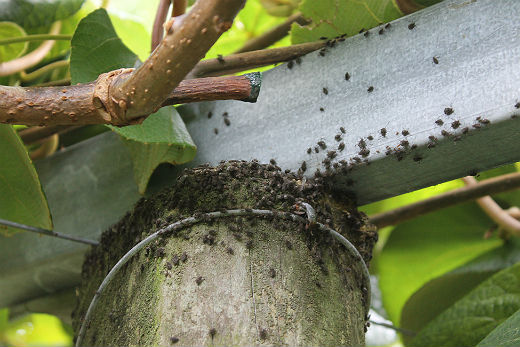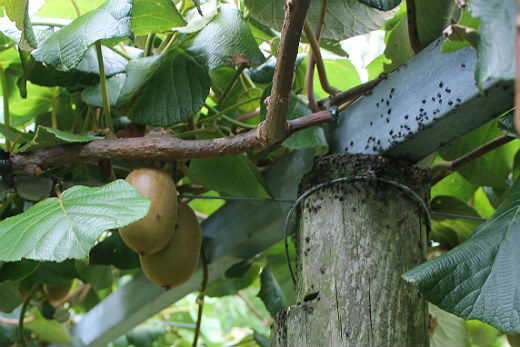Omokoroa kiwifruit grower Neil Brough fears the thousands of insects crawling over the support structures, vines and fruit on his orchard may represent yet another serious threat to the industry.
'We've identified them as giant willow aphid and since we first noticed them on willow shelter in the orchard on Monday, they have moved, in big numbers, to the kiwifruit,” says Neil.
Hundreds of giant willow aphids are crawling over fruit and kiwifruit support structures on Neil Brough's gold kiwifruit orchard near Omokoroa.
Neil believes they are a new pest for kiwifruit and understands they were first identified in New Zealand in 2013.
'My concern is that they will cause sooty mould to grow on the fruit which may see it rejected for export.”
Neil says he and his staff first became aware of the insects when they noticed the trunks and stems on the willow shelter turning black with mould. Sooty molds are caused by Ascomycete fungi which grow on the sugary honeydew secreted by insects such as aphids, scales, and cicada.
'There's no sooty mould on the fruit yet but you can see the on the leaves where the aphids have excreted honeydew and they are crawling on the fruit so I expect areas of the leaves and the fruit to turn black,” says Neil.
Neil has notified Kiwifruit Vine Health, Zespri and the Ministry of Primary Industries.
KVH reports the organisation and Zespri are in discussion with MPI about the insect. This week's KVH bulletin says both entities are working to determine the scale of the problem and develop best practice recommendations.
The insect is found in most countries New Zealand exports to and is not considered a quarantine pest.
'It is quite common for aphids to develop to very high numbers very quickly then collapse again equally rapidly,” says the bulletin.
Giant willow aphid (Tuberolachnus salignus) was first reported in New Zealand in December 2013 and has since been discovered throughout the North Island and in the Tasman Region.
The KVH bulletin says that MPI conducted an incursion investigation when it was first reported and concluded that GWA are a known pest to willow and poplar trees and kiwifruit is not a known host (initial reports indicate the aphids are not feeding on kiwifruit).
However, horticultural industries could be impacted given the use of willow trees in orchard shelter belts.
Neil is still waiting for advice from Zespri and KVH on what sprays he can use to control the insects as this time of the year, very close to harvest, the kinds of sprays available to growers are restricted.
'Oils might control them, but killing them won't stop the sooty mould problem they have probably already caused.”
More than that, he is concerned that yet another new pest has apparently arrived in New Zealand.
Like virtually every other kiwifruit orchard, his has been infected with the bacterial disease Psa first identified in New Zealand in 2010. He removed both green and gold vines and the giant willow aphids are on a block of the orchard grafted to the new G3 variety which is carrying a promising-looking export crop.
Two weeks ago two white peach scale insects, a species which has caused significant problems for the industry in Italy, were spotted by a Plant & Food Research scientist on imported Italian fruit in a Tauranga supermarket.
'New Zealand needs tougher controls at our borders. These pests and Psa are bad enough but if foot and mouth disease arrived it would just about bankrupt our country,” says Neil.
Foot and mouth disease seriously affects livestock including dairy cows and an outbreak would see thousands of livestock slaughtered and countries closing their borders to most of our exports.
Giant willow aphids have an unusual lifecycle, with only wingless female born in spring, followed by several generations of egg-laying females with no males produced until finally more females with wings are hatched which return to the host willow trees in autumn when one batch of eggs hatch as males and females. These mate, the females lay eggs which over-winter, with wingless females emerging in spring.






6 comments
Yet Another Failure
Posted on 14-02-2014 09:04 | By Disappointed
You can lay the blame squarely at the feet of this government and their ill thought "restructuring" of frontline biosecurity services. Just like Novopay any gains anticipated have been lost in the extra costs of picking up the pieces.
@You.could.say.that
Posted on 14-02-2014 09:59 | By Sambo Returns
just to clarify something..... this government were not the instigators of the "Novapay" debacle, but as usual they had to clean up the bloody mess!!!!, as for the Bio Security issue, try looking at the bureaucrats/scientists in charge first.
Dish liquid
Posted on 14-02-2014 13:34 | By sojourner
We had lots of aphids doing their sooty mold damage this Summer. I mixed some dishwashing liquid with water and sprayed that on the plants which killed them in moments.I repeated it a week later and they haven't been back. Say what? Why is NZ importing Kiwifruit at all? When surplus is being fed to cows? Bio security is actually very tight. Why always point the finger at others when generally they are doing a very good job and can only go by the book? These things happen and not because either government or bio security officers are at fault.
Clarification @ Sambo Returns
Posted on 14-02-2014 18:59 | By Disappointed
The "Novapay" (sic) payroll system was implemented in August of 2012. Although the contract had been awarded to Talent2 in 2005 it was this National government who, even with knowledge of unresolved issues, chose to go live with it. The debacle that followed was an embarrassment to Hekia Parata and contributed to the resignation of the Education Secretary Leslie Longstone. This cannot be contested. Furthermore the mess is still a mess! Yesterday it was reported that an average of 6 teachers per school were affected by Novopay errors last week. Today school staff inform me that next weeks pay round is looking no better.
Budget Cuts = Aphids
Posted on 14-02-2014 19:22 | By Disappointed
In May 2009 the Budget delivered funding cuts for MAF Biosecurity by $1.9 million. A result has been substantial frontline job losses. @ sojourner... It was never my intent to disparage the job that biosecurity officers do but to take issue with a government that has repeatedly demonstrated questionable priorities.
Citizen science
Posted on 17-02-2014 10:43 | By jonsullivan
Note that this aphid was first reported on 23 December 2013 on the online citizen science project, NatureWatch NZ, by Auckland entomologist Stephen Thorpe. See http://naturewatch.org.nz/observations/379630. He then reported it to MPI and they subsequently found in established at many other places. NatureWatch NZ is free to join and anyone can upload photos for identification. Since we launched in August 2012, New Zealanders have reported over 50 species not previously known in New Zealand (including one new native moss), as well as some substantial range expansions of pests and weeds. While it is important to debate the appropriate government investment in front line biosecurity staff, we can all play a part by reporting unusual new things. Even the most expensive and high tech border security system will not keep everything out and early detection is our next best defense.
Leave a Comment
You must be logged in to make a comment.